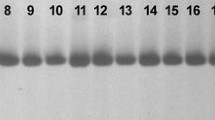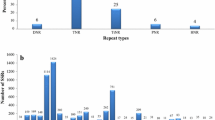Abstract
Jatropha curcas has been a species of interest all over the world due to its potential as a renewable biodiesel crop. In the present paper, a set of 40 novel genomic microsatellites from Jatropha developed through cloning and sequencing are reported. The microsatellite markers were evaluated at intra-specific, inter-specific and inter-generic levels. All forty markers successfully amplified fragments from J. curcas and J. integerrima showing their potential in linkage mapping using inter-specific breeding populations involving these species. The average number of alleles within 12 core accessions of J. curcas was 3.083. Polymorphic information content ranged from 0.15 to 0.80 within J. curcas accessions and from 0 to 0.37 among different genera. There was no significant deviation from Hardy–Weinberg equilibrium or linkage disequilibrium. Ten of these microsatellites showed polymorphism within Emblica officinalis while thirteen were polymorphic within Phyllanthus niruri and Ricinus communis accessions. These new set of microsatellite markers are expected to be especially useful in future for linkage mapping in J. curcas and for varietal identification and genetic diversity studies in other genera mentioned above.
Similar content being viewed by others
References
Tewari DN (2003) Report of the committee on development of Bio-fuel. Planning Commission, Government of India, New Delhi
Openshaw K (2000) A review of Jatropha curcas L: an oil plant of unfulfilled promise. Biomass Bioenergy 19:1–15
Semagn K, Bjørnstad A, Ndjiondjop MN (2006) Principles, requirements and prospects of genetic mapping in plants. Afr J Biotechnol 5(25):2569–2587
Tatikonda L, Wani SP, Kannan S, Beerelli N, Sreedevi TK, Hoisington DA, Devi P, Varshney RK (2009) AFLP-based molecular characterization of an elite germplasm collection of Jatropha curcas L., a biofuel plant. Plant Sci 176(4):505–513
Basha S, Sujatha M (2007) Inter and intra-population variability of Jatropha curcas (L.) characterized by RAPD and ISSR markers and development of population-specific SCAR markers. Euphytica 156:375–386
Basha SD, George F, Makkar HPS, Becker K, Sujatha M (2009) A comparative study of biochemical traits and molecular markers for assessment of genetic relationships between Jatropha curcas (L.) germplasm from different countries. Plant Sci 176:812–823
Sudheer PDVN, Pandya N, Reddy MP, Radhakrishnan T (2009) Comparative study of interspecific genetic divergence and phylogenic analysis of genus Jatropha by RAPD and AFLP. Mol Biol Rep 36:901–907. doi:10.1007/s11033-008-9261-0
Sinha P, Negi MS, Sharma SS, Md Islam A, Tripathi SB (2013) Analysis of genome-wide homozygosity in Jatropha curcas accessions using AFLP markers. Int J Res Pharm Sci 3:191–201
Tanya P, Dachapak S, Tar MM, Srinives P (2011) New microsatellite markers classifying nontoxic and toxic Jatropha curcas. J Genet 90:e76–e78
Bressan EA, Scotton DC, Ferreira RR, Jorge EC, Sebbenn AM, Gerald LTS, Figueira A (2012) Development of microsatellite primers for Jatropha curcas (Euphorbiaceae) and transferability to congeners. Am J Bot 99(6):e237–e239. doi:10.3732/ajb.1100532
Wang CM, Liu P, Yi C, Gu K, Sun F, Li L, Lo LC, Liu X, Feng F, Lin G, Cao S, Hong Y, Yin Z, Yue GH (2011) A first generation microsatellite—and SNP-based linkage map of Jatropha. PLoS One 6(8):e23632
Phumichai C, Phumichai T, Kongsiri N, Wongkaew A, Sripichit P, Kaveeta R (2011) Isolation of 55 microsatellite markers for Jatropha curcas and its closely related species. Biol Plant 55(2):387–390. doi:10.1007/s10535-011-0061-3
Sudheer PD, Rahman H, Mastan SG, Reddy MP (2010) Isolation of novel microsatellites using FIASCO by dual probe enrichment from Jatropha curcas L. and study on genetic equilibrium and diversity of Indian population revealed by isolated microsatellites. Mol Biol Rep 37(8):3785–3793. doi:10.1007/s11033-010-0033-2
Yadav HK, Ranjan A, Hasan AM, Mantri S, Sawant S, Tuli R (2011) EST-derived SSR markers in Jatropha curcas L.: development, characterization, polymorphism, and transferability across the species/genera. Tree Genet Genomes 7(1):207–219. doi:10.1007/s11295-010-0326-6
Wen M, Wang H, Xia Z, Zou M, Lu C, Wang W (2010) Development of EST-SSR and genomic-SSR markers to assess genetic diversity in Jatropha curcas L. BMC Res Notes 3(1):42
Mastan SG, Pamidimarri DVNS, Rahman H, Ghosh A, Rathore MS, Ravi Prakash C, Chikara J (2012) Molecular characterization of intra-population variability of Jatropha curcas L. using DNA based molecular markers. Mol Biol Rep 39(4):4383–4390. doi:10.1007/s11033-011-1226-z
Sudheer PD, Mastan SG, Rahman H, Prakash ChR, Singh S, Reddy MP (2011) Cross species amplification ability of novel microsatellites isolated from Jatropha curcas and genetic relationship with sister taxa: cross species amplification and genetic relationship of Jatropha using novel microsatellites. Mol Biol Rep 38(2):1383–1388. doi:10.1007/s11033-010-0241-9
Chan AP, Crabtree J, Zhao Q, Lorenzi H, Orvis J, Puiu D, Melake-Berhan A, Jones KM, Redman J, Chen G, Cahoon EB, Gedil M, Stanke M, Haas BJ, Wortman JR, Fraser-Liggett CM, Ravel J, Rabinowicz PD (2010) Draft genome sequence of the oilseed species Ricinus communis. Nat Biotechnol 28(9):951–956
Sharma SS, Negi MS, Sinha P, Kumar K, Tripathi SB (2011) Assessment of genetic diversity of biodiesel species Pongamia pinnata accessions using AFLP and three endonuclease-AFLP. Plant Mol Biol Rep 29(1):12–18
Zane L, Bargelloni L, Patarnello T (2002) Strategies for microsatellite isolation: a review. Mol Ecol 11:1–16
Schuelke M (2000) An economic method for the fluorescent labelling of PCR fragments. Nat Biotechnol 18:233–234
Weir BS (1990) Genetic data analysis: methods for discrete population genetic data. Sinauer Associates Inc, Sunderland
Liu K, Muse SV (2005) PowerMarker: an integrated analysis environment for genetic marker analysis. Bioinformatics 21(9):2128–2129
Perrier X, Jacquemoud-Collet JP (2006) DARwin software, version 5.0.158. http://darwin.cirad.fr/darwin
Na-ek Y, Wongkaew A, Phumichai T, Kongsiri N, Kaveeta R, Reewongchai T, Phumichai C (2011) Genetic diversity of physic nut (Jatropha curcas L.) revealed by SSR markers. J Crop Sci Biotechnol 14(2):105–110
Sun Q-B, Li L-F, Li Y, Wu G-J, Ge X-J (2008) SSR and AFLP markers reveal low genetic diversity in the biofuel plant Jatropha curcas in China. Crop Sci 48(5):1865–1871. doi:10.2135/cropsci2008.02.0074
Parthiban KT, Kumar RS, Thiyagarajan P, Subbulakshmi V, Vennila S, Rao MG (2009) Hybrid progenies in Jatropha—a new development. Curr Sci 96(6):815–823
Prabakaran AJ, Sujatha M (1999) Jatropha tanjorensis Ellis & Saroja, a natural interspecific hybrid occurring in Tamil Nadu, India. Genet Resour Crop Evol 46(3):213–218. doi:10.1023/a:1008635821757
Kumar RS, Parthiban KT, Hemalatha P, Kalaiselvi T, Rao MG (2009) Investigation on cross-compatibility barriers in the biofuel crop Jatropha curcas L. with wild Jatropha species. Crop Sci 49(5):1667–1674. doi:10.2135/cropsci2008.10.0601
Acknowledgments
The authors acknowledge the gracious funding provided by the Department of Biotechnology, Government of India. Pratima Sinha is thankful to the Ministry of New and Renewable Energy (MNRE), Government of India, for providing fellowship for this work. The authors are also thankful to Dr. R. K. Pachauri, Director General, TERI, for his kind support.
Conflict of interest
The authors declare that they have no conflict of interest.
Author information
Authors and Affiliations
Corresponding author
Electronic supplementary material
Below is the link to the electronic supplementary material. Supplementary Fig. 1. Dendrogram showing UPGMA clustering of 12 core accessions of Jatropha curcas. Bootstrap values over 50 were considered to be significant and are shown in the dendrogram.
Rights and permissions
About this article
Cite this article
Sinha, P., Islam, M.A., Negi, M.S. et al. Development of Novel Microsatellite Markers in Jatropha curcas and Evaluation of Their Cross-Species Transferability. Proc. Natl. Acad. Sci., India, Sect. B Biol. Sci. 85, 1011–1016 (2015). https://doi.org/10.1007/s40011-015-0489-x
Received:
Revised:
Accepted:
Published:
Issue Date:
DOI: https://doi.org/10.1007/s40011-015-0489-x




